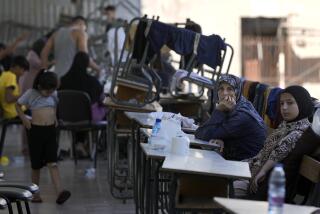Salvador Civilians Become Pawns in a Changing War
SAN SALVADOR — Using a classic counterinsurgency tactic, the armed forces of El Salvador are transplanting civilians who support guerrillas from combat zones to government-controlled areas.
During five years of civil war in this country, the armed forces often considered the idea of separating civilians from guerrillas, a move aimed at denying the rebels food and shelter and at creating “free-fire zones,” where anyone remaining behind would be considered hostile--and fair game for attack.
Because of political considerations, civilians were removed only occasionally in the past. Recently, however, attitudes have changed.
“It’s preferable to take the civilians out than be accused of killing them,” said Maj. Carlos Aviles, the armed forces spokesman.
The project is less than systematic. In some guerrilla-dominated zones, civilians are left alone. In others, helicopters have been sent to pluck out farmers and their families by the hundreds.
In neighboring Guatemala and Nicaragua, the governments have for some time relocated suspected rebel supporters. In those countries, authorities set up camps with makeshift housing, supplies and land to till.
In El Salvador, however, the government has made little provision to care for the displaced. Once moved out of their mountain homes, they are turned over to relief agencies for location in already crowded refugee camps.
The camps, thick with smoke from tortilla ovens and dust from newly beaten pathways among open buildings, offer few amenities. Hundreds of ragged children and round-bellied, naked tots scurry from relative to relative seeking food, a hug or a game.
Many of the displaced people leave the camps to join relatives living elsewhere, and some head back into the hills.
War has driven an estimated half a million Salvadorans from their homes to an uncertain life elsewhere in this country. Another half million are believed to have fled to the United States.
The region around the massive central mountain called Guazapa seems to be a special target for the current displacement moves, although the army has also relocated residents of the eastern province of Morazan and the northern province of Chalatenango.
Many of the displaced people were longtime supporters of the rebels of the Farabundo Marti National Liberation Front. In leftist guerrilla jargon, they are masas --the masses--organized by the rebels to supply food, shelter and, often, men for combat.
After years of army sweeps and frequent aerial bombing and artillery attacks, it is a wonder that anyone besides the guerrillas still lives in the battle zones. That many civilians remain--an estimated 50,000 to 100,000--is a tribute both to guerrilla organization and traditional Salvadoran ties to the land.
Nonetheless, in recent weeks rebel supporters, as well as neutral civilians, have been trickling down from the mountains, frightened particularly of the Salvadoran armed forces’ new air power.
War Happened Elsewhere
“When we were first organized, we thought war was what happened in other countries. Later, we learned better,” said Gabriel Arteaga, 50, from Corozal, a village on the slopes of Guazapa.
Arteaga and about 200 other guerrilla supporters were picked up by the army last April and flown to the Betana refugee camp near San Salvador. They had helped feed and shelter guerrillas from the Central American Workers Revolutionary Party, one of five main armed rebel factions that make up the Farabundo Marti Front.
The guerrilla supporters were caught after fleeing from a military assault near their village.
“When the bombing started, we fled and hid,” said Antonio Rodriguez, 69.
He described the hand-dug shelters, known as tatus , that the guerrillas taught them to build.
Built for 10, Holds 50
“The tatu was built for 10, but when the shooting begins, it fits 50,” Rodriguez said.
A spy led the soldiers to the tatu, the refugees said. Shortly afterward, the helicopters transported the rebel backers from the mountain to the camp.
“We’re not afraid anymore. Once you’re in their hands, what can you do?” said Francisco Duran, 59. “At least no bombs fall here.”
Still, since April, several displaced families have returned to Guazapa, the refugees said.
In Morazan province, the army forcibly relocated some peasants who apparently did not support the rebels.
During a sweep last month, residents of Sabanetas, a border town near Honduras, were told to evacuate.
“The soldiers saw that we had medicines and so assumed we were with the guerrillas,” said Benigna Argueta, 53. “The Red Cross gave us the medicines. They were for us.”
Caught in Middle
The army did not provide transportation for the Sabanetas group, leaving the farmers caught in the middle. The guerrillas, who buy food from the residents and force them to work in rebel-controlled fields once a week, did not want the civilians to leave and forbade the families from taking away their belongings.
“We find problems no matter what we do,” sighed Angel Maximo Sorto, 62.
As of last week, the refugees from Sabanetas were stalled in the town of La Tijera.
In some parts of El Salvador, danger from combat and random violence has prompted residents to flee without invitation or coercion.
Guazapa mountain was once home to 50,000 farmers of hardscrabble fields. Now, perhaps 5,000 remain, relief officials estimate.
There are also indications that the rebels themselves are organizing some families to leave.
Recently, groups of villagers have descended on the Domus Mariae refugee camp in San Salvador seeking shelter. They were once organized into support groups by two Farabundo Marti factions, the Popular Liberation Forces and the Armed Forces of Liberation.
Women and Children
Most of the recent arrivals are children and women, nearly all of the latter claiming to be widows, although their accounts of their husbands’ deaths are somewhat vague.
“The soldiers come and destroy the crops, the houses, burn our clothes. It is unbearable,” said Yolanda Hernandez, 45, from the much-attacked village of Platanares.
Maria Gonzalez, 60, has two sons who fight for the rebels and four granddaughters married to rebels.
“When it began, in 1980, they promised us a better life. That’s what we were fighting for,” said Gonzalez. “It hasn’t turned out that way.”
She expects her granddaughters to abandon the mountains soon. Her sons will stay, she said, feeding themselves from the harvests of collective farms still operating on the volcanic slopes of Guazapa.
More to Read
Sign up for Essential California
The most important California stories and recommendations in your inbox every morning.
You may occasionally receive promotional content from the Los Angeles Times.










